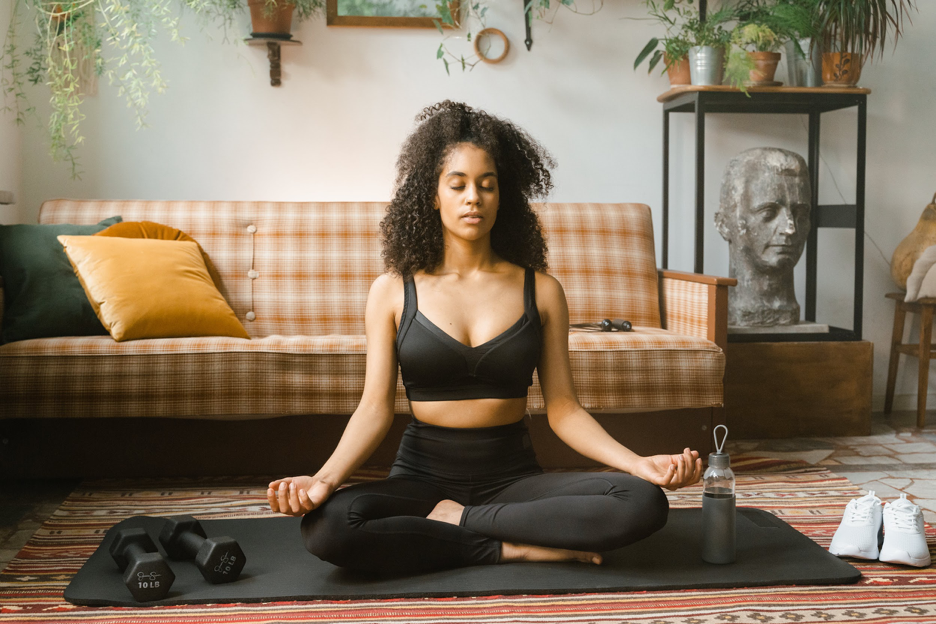Mindfulness: What does it really mean and why do people keep saying it?


Ever heard the phrase, “live in the moment?” Or, been told to “just chill out, “relax,” or “don’t think about it?” Ever want to punch those people? No? Good! I don’t condone violence… If we could relax and live in the present moment, most of us would choose to. It would be so peaceful if we could just turn off the noise. Unfortunately, there is no “off switch” to our thoughts. Our brains are busy even when we are sleeping, but there are things we can do that can allow us to slow down, to move with more intention, and live with a bit more ease. That’s where mindfulness comes in.
There are many ways we can incorporate mindfulness into our daily lives. I primarily want to focus on the practice of mindfulness meditation. I will start by prefacing that I am not a master of meditation, and recognize there is still so much I will continue to learn. I have observed great change both personally and professionally when mindfulness and/or meditation is incorporated into a daily routine. It’s also important to note that there is no “correct” version of what mindfulness is. There are many interpretations across different schools of thought and cultures, some practices dating back 2,500+ years. The common denominator is the shared interest in reducing suffering, enhancing positive emotions, and improving quality of life.
To start, what is mindfulness meditation? If you Google it you will get a lot of varying answers. The common theme in the definitions is that it is a form of mental training practice that aims to slow down our busy minds. Mindfulness is a mental state that focuses on the “now” so we can acknowledge our thoughts, feelings, and bodily sensations without judgment. Meditation is the act of sitting down and creating the space to tune into ourselves, often focusing on the mind-body connection. Put it together and we are creating space in our daily lives to acknowledge everything that is going on inside us, without feeling judged, compared, or critiqued. A safe space for yourself.
The science behind it! Our brain is a muscle and it requires exercise (beyond the daily gymnastics it typically does). Think about the other muscles in our body. If we want them to change, we exercise to build muscular strength and endurance. We can even change our physique. Our brain is no different. Studies show that incorporating mindfulness meditation can actually change the structure and function in brain regions associated with attention, emotion, self-awareness, and memory. Consistent meditation is correlated to a reduction of stress (among other emotions often linked to anxiety, depression, self-esteem, and more). Furthermore, experienced meditators have shown to have significant changes in their brain structure. Their brains physically changed!
Since this is a blog and not a research paper, I’ll try to summarize why acknowledging the structure of the brain is important. There is this little part of our brain called the Amygdala. The amygdala is the major processing center for emotions. It helps to store memories and events so that we can be able to recognize similar events in the future. I hope things are starting to click here! How often do we experience a negative event and we feel like it haunts us, or is burned into our brain? So, we ruminate and remain vigilant to make sure we don’t feel anything remotely close to that feeling again. We will go to great lengths to avoid a feeling or situation… because your brain perceives a threat and tells you to run away! Meditation helps us calm that annoying voice in our mind (our amygdala) so that we don’t jump straight into fight or flight.
There is so much more to unpack about the changes our brains undergo when we utilize mindfulness meditation. Since brevity is not my strength, this is a great, short video that breaks down some of the changes that can occur in our brain.
Neuroscience of Mindfulness Meditation in 4 minutes
It seems simple. Why aren’t we all meditating? Why isn’t this common practice? In my opinion, there are a few common myths/barriers to stepping into a new practice.
Meditation greatly challenges the engrained message that we need to constantly be working, striving, or productive. The act of stopping to acknowledge emotions, or even the concept of rest is really difficult for a lot of people. I’ve had many clients flat out say it seems wasteful. Rest is productive! Even machines need a break so they are not overworked. We feel feelings, whether we like them or not so creating space for rest and acknowledgement of our experiences is important.
Another big reason meditation is often met with aversion is that it can be emotionally uncomfortable. Meditation directly challenges what our brains are designed to do. The act of sitting with ourselves and trying to slow down a mechanism that wants to move fast can be difficult. But that’s kind of the point. If we allow our minds to just run freely all of the time, we are going to stick with that pace for as long as we can. The problem is that it’s often not sustainable. Practicing mindfulness meditation aids in calming our minds and creating opportunities to slow down, and move with a little more ease.

The most common barrier client’s have voiced is “I’m not good at it.” You personally can’t meditate. You can’t sit still for that long, you can’t focus, you’re a bad meditator. There is NO such thing as a bad meditator. There are going to be days where our mind is busier and it will take more effort, but that doesn’t mean you did it wrong or are bad at it. The entire point of meditation is to be mindful of if/when our thoughts run away, and how to gently bring them back to the present focus. Remember my earlier rant about our brains being busy? Your mind is going to wander if you give it the space to wander! Let it run! And with practice we slowly get better at bringing it back to what we need to focus on. There is no grade or measuring stick for how “well” you are meditating. Even if it feels like you “aren’t doing it right,” you are making a choice to dedicate time to yourself. That’s often not easy to do, but is the ultimate act of self-love.
We ALL have busy minds! Again, that’s the exact function of our brains: To think; To take in stimulus; To assess threat, whether emotional or physical; To keep us alive and functioning. Our brain has to do a lot of work. Having a busy mind is just part of being human.
There are two simple components to meditation:
- Awareness. Being present on purpose.
- Non-judgement, compassion, love, kindness… choose your word.
With awareness we are bringing our attention to one thing. Think of how many times you have tried to stop thinking about something. It often ends up being the only thing we can think about. So rather than focusing on the chatter, we are bringing our awareness to our body. Sometimes it can be by using our breath or paying attention to the physical sensations in our body. The non-judgmental component is important because we want to eliminate layering on feelings of doubt or self-consciousness. The overall goal is to be present with a kind and loving sense. Treat yourself the way you would treat a friend. There is no benefit to beating yourself up. We are already experts at that. So a challenge within this is to give ourselves credit. Guilt and shame often aren’t great motivators, so we might as well try to become our own cheerleaders.
One of my favorite guided meditation instructors (shout out to Aditi Shah with Peloton) does a wonderful job summarizing what the embodiment of meditation really is:
“Meditation happens in a place of relaxation. We live in a culture that is constantly moving forward. You probably have a to-do list in the back of your mind somewhere. Meditation can feel difficult because it’s really going against the grain. It’s asking us to be RIGHT HERE. Not in the past, not in the future, but right here in the present moment. It’s also asking us to be non-judgmental. To let go of our preconceived notions, our expectations, to let go of our conditioning and these stories that we layer on through life. Being a human is hard. We have waves of experience. We have moments of joy, we get to fall in love, but sometimes the price we pay for being human is experiencing pain, or heartbreak. We have all been disappointed. And when we have to go through these experiences we often grow stronger, but we also sometimes put on a little armor. Meditation is asking us to get beneath the armor and get intimate with ourselves. AND to do that with compassion and kindness.”
Remember, meditation is a practice. It’s not meant to be perfect. Just like us.

If you are looking for a place to start, I am partial to Peloton meditation (I am not a sponsor for Peloton- simply my personal preference). This does not require the purchase of the bike or treadmill, and gives you access to other workouts as well. I found this helpful as there is an “Intro to Meditation” program that is 3 weeks, ranging from 7-10 classes. All short in duration and truly walks you through how to step into meditation.
Other known apps are Headspace, Calm (which primarily uses soundscapes), and good ol’ YouTube. You can target your search to focus on a specific feeling, or simply start your search with “beginner’s guided meditation.”
Alternative and related articles;
Benefits of meditation;
https://www.healthline.com/nutrition/12-benefits-of-meditation#6.-May-reduce-age-related-memory-loss
A brief introduction on how to start meditation;
https://www.verywellmind.com/mindfulness-meditation-88369
A deeper dive into mindfulness, meditation, and how it can improve our mental health;
https://www.nccih.nih.gov/health/meditation-and-mindfulness-what-you-need-to-know
The Amygdala;
https://my.clevelandclinic.org/health/body/24894-amygdala
